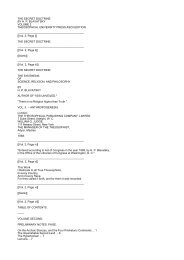Create successful ePaper yourself
Turn your PDF publications into a flip-book with our unique Google optimized e-Paper software.
The Legend Of RA And Isis.<br />
become almost national gods; and <strong>the</strong> gods who are <strong>the</strong> companions <strong>of</strong> Osiris are endowed by <strong>the</strong> pious<br />
with all <strong>the</strong> attributes <strong>of</strong> <strong>the</strong> great cosmic gods--Ra, Ptah, Khnemu, Khepera, and <strong>the</strong> like. Thus <strong>the</strong><br />
attributes <strong>of</strong> Ra are bestowed upon Khnemu and Khepera; <strong>the</strong> god Horus exists in <strong>the</strong> aspects <strong>of</strong><br />
Heru-maati, Heru-khent-an-maa, Heru-Khuti, Heru-nub, Heru-behutet, etc., and <strong>the</strong> attributes <strong>of</strong> each are<br />
confounded ei<strong>the</strong>r in periods or localities: Tmu-Ra, and Menthu-Ra, and Amen-Ra are composed <strong>of</strong> Tmu<br />
and Ra, and Menthu and Ra, and Amen and Ra respectively, and we have seen from <strong>the</strong> hymn quoted<br />
above (p. lii.) that already in <strong>the</strong> XVIIIth dynasty <strong>the</strong> god Osiris had absorbed <strong>the</strong> attributes which<br />
belonged in <strong>the</strong> earlier dynasties to Ra alone.<br />
History <strong>of</strong> <strong>the</strong> god Amen.<br />
Still more remarkable, however, is <strong>the</strong> progress <strong>of</strong> <strong>the</strong> god Amen in Egyptian <strong>the</strong>ology. In <strong>the</strong> early<br />
empire, i.e., during <strong>the</strong> first eleven dynasties, this god ranked only as a local god, although his name is as<br />
old as <strong>the</strong> time <strong>of</strong> Unas;[3] and<br />
[1. E.g., <strong>the</strong> litany from <strong>the</strong> tomb <strong>of</strong> Seti I., published by Naville, La Litanie du Soleil, Leipzig, 1875, p. 13 ff.<br />
2. E.g., Hymn to Amen-Ra, translated by Goodwin from papyrus No. 17, now preserved in <strong>the</strong> Gizeh Museum (see Les<br />
Papyrus Égyptiens du Musée de Boulaq, ed. Mariette, Paris, 1872, pll. 1-13; Records <strong>of</strong> <strong>the</strong> Past, vol. i., p. 127 f., and<br />
Trans. Soc. Bibl. Arch., vol. ii., p. 250), and by Grébaut, Hymne à Ammon-Ra, Paris, 1874); Hymns to Amen, translated by<br />
Goodwin (see Records <strong>of</strong> <strong>the</strong> Past, vol. vi., p. 97 f.; Trans. Soc. Bibl. Arch., vol. ii., p. 353), and Chabas (Mélanges<br />
Égyptologiques, 1870, p. 117); Hymn to Osiris, translated by Chabas (Revue Archéologique, t. xiv., Paris, 1857, p. 65 ff.),<br />
and Goodwin (Records <strong>of</strong> <strong>the</strong> Past, vol. iv., p. 97 ff.). The various versions <strong>of</strong> <strong>the</strong> XVth Chapter <strong>of</strong> <strong>the</strong> <strong>Book</strong> <strong>of</strong> <strong>the</strong> <strong>Dead</strong>,<br />
which consists <strong>of</strong> a series <strong>of</strong> hymns, are given in <strong>the</strong> Theban edition by Naville (Todtenbuch, Bd. I., Bll. 14-23), and <strong>the</strong><br />
text <strong>of</strong> <strong>the</strong> later Saïte version is discussed and translated by Lefébure, Traduction comparée des hymnes au Soleil, Paris,<br />
1868, 4to.<br />
3. "Amen and Ament," are mentioned in 1. 558 <strong>of</strong> <strong>the</strong> inscription <strong>of</strong> this king; see Maspero, Recueil, t. iv., p. 66.]<br />
{p. xcv}<br />
it is not until <strong>the</strong> so-called Hyksos have been expelled from Egypt by <strong>the</strong> Theban kings <strong>of</strong> <strong>the</strong> XVIIth<br />
dynasty that Amen, whom <strong>the</strong> latter had chosen as <strong>the</strong>ir great god, and whose worship <strong>the</strong>y had declined<br />
to renounce at <strong>the</strong> bidding <strong>of</strong> <strong>the</strong> Hyksos king Apepi,[l] was acknowledged as <strong>the</strong> national god <strong>of</strong><br />
sou<strong>the</strong>rn Egypt at least. Having by virtue <strong>of</strong> being <strong>the</strong> god <strong>of</strong> <strong>the</strong> conquerors obtained <strong>the</strong> position <strong>of</strong><br />
head <strong>of</strong> <strong>the</strong> company <strong>of</strong> Egyptian gods, he received <strong>the</strong> attributes <strong>of</strong> <strong>the</strong> most ancient gods, and little by<br />
little he absorbed <strong>the</strong> epi<strong>the</strong>ts <strong>of</strong> <strong>the</strong>m all. Thus Amen became Amen-Ra, and <strong>the</strong> glory <strong>of</strong> <strong>the</strong> old gods <strong>of</strong><br />
Annu, or Heliopolis, was centred in him who was originally an obscure local god. The worship <strong>of</strong> Amen<br />
in Egypt was fur<strong>the</strong>red by <strong>the</strong> priests <strong>of</strong> <strong>the</strong> great college <strong>of</strong> Amen, which seems to have been established<br />
early in <strong>the</strong> XVIIIth dynasty by <strong>the</strong> kings who were his devout worshippers. The extract from a papyrus<br />
written for <strong>the</strong> princess Nesi-Khonsu,[2] a member <strong>of</strong> <strong>the</strong> priesthood <strong>of</strong> Amen, is an example <strong>of</strong> <strong>the</strong><br />
exalted language in which his votaries addressed him.<br />
"This is <strong>the</strong> sacred god, <strong>the</strong> lord <strong>of</strong> all <strong>the</strong> gods, Amen-Ra, <strong>the</strong> lord <strong>of</strong> <strong>the</strong> throne <strong>of</strong> <strong>the</strong> world, <strong>the</strong> prince<br />
<strong>of</strong> Apt,[3] <strong>the</strong> sacred soul who came into being in <strong>the</strong> beginning, <strong>the</strong> great god who liveth by right and<br />
truth, <strong>the</strong> first ennead which gave birth unto <strong>the</strong> o<strong>the</strong>r two enneads,[4] <strong>the</strong> being in whom every god<br />
existeth, <strong>the</strong> One <strong>of</strong> One,[5] <strong>the</strong> creator <strong>of</strong> <strong>the</strong> things which came into being when <strong>the</strong> earth took form in<br />
<strong>the</strong> beginning, whose births are hidden, whose forms are manifold, and whose growth cannot be known.<br />
The sacred Form, beloved, terrible and mighty in his two risings (?), <strong>the</strong> lord <strong>of</strong> space, <strong>the</strong> mighty one <strong>of</strong><br />
<strong>the</strong> form <strong>of</strong> Khepera, who came into existence through Khepera, <strong>the</strong> lord <strong>of</strong> <strong>the</strong> form <strong>of</strong> Khepera; when<br />
he came into being nothing existed except himself. He shone upon <strong>the</strong> earth from primeval time [in <strong>the</strong><br />
http://www.sacred-texts.com/egy/ebod/ebod07.htm (5 <strong>of</strong> 10) [8/10/2001 11:23:38 AM]

















